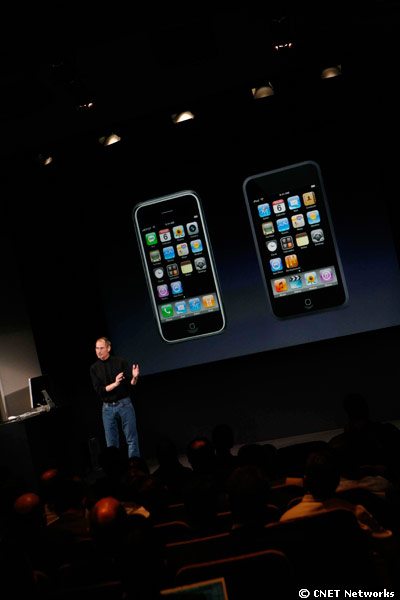iPhone in your business: Pondering the ROI case

Apple has dressed the iPhone up in a business suit, but the real work is just beginning. Apple needs to convince chief information officers that there's a return on investment in a switch to the iPhone.
The day after an Apple event is always the analysis day. You get wowed by Steve Jobs. You go ga-ga for the eye candy. You're ready to buy every Apple product on earth. And then the buzz wears off a bit. That's what corporate America is waking up to following Thursday's iPhone SDK and enterprise feature extravaganza (Techmeme, notebook, photos, video, all iPhone resources and News.com).
The question for any enterprise pondering the iPhone is this: Where are the savings? Given IT budgets are likely to get cut Apple will need a compelling ROI case if it's going to upend Research in Motion, which was clearly the target of multiple jabs at Apple's shindig.
The hard numbers will vary by company. Some analysts say like BMO Capital Markets' Keith Bachman expect that Apple will first make inroads into small and medium-sized businesses.
In a research note, Bachman writes:
"We believe Apple still faces some roadblocks in the mid- to large-enterprise accounts, but will make better inroads in the small- and medium-business market, similar to its CPUs."
Bachman's argument goes like this: CIOs are reluctant to allow multiple devices and operating systems into their environment. Why? It's total cost of ownership. You need more people to support various devices and operating systems. That's why the one-vendor-to-choke model is appealing.
Bachman also makes another key point: Apple's enterprise friendly moves--support for Microsoft Exchange, remote wipe, push email and contact synching--just get the company into the business conversation. For Apple, those features are merely the price of admission to reach CIOs.
Bachman writes:
"Given the proliferation of BlackBerry, Windows Mobile, and other mobile devices that support wireless personal information management (PIM) functionality, Apple's announcement is not breakthrough in our view, but a minimum requirement to crack one of the barriers of the enterprise segment. We believe Apple's decision to license Microsoft's Exchange ActiveSync is the right strategy, rather than Research in Motion's BlackBerry Connect and Motorola's Good Technology, among others, given the large installed base of Microsoft Exchange Servers."
Indeed, few analysts on Friday are predicting the demise of RIM over Apple's move. And there's a good reason for that take--RIM is entrenched with CIOs. Even other devices from Nokia and Motorola that work with RIM technology don't hold a candle to the BlackBerry among large corporations.
Citigroup analyst Richard Gardner says:
"While Apple claims superior reliability and security with ActiveSync, RIM currently enjoys an overwhelmingly dominant position within the enterprise installed-base."
Analysts, however, say that Apple has a lower inertia hurdle to clear with smaller companies. Meanwhile, software as a service is prevalent in small to mid-sized businesses. That's where iPhone's Web browsing capability shines. With the iPhone and SaaS smaller corporations suddenly have all the in-the-field access that larger rivals do.
But since iPhone is at least in the conversation now, businesses will have to do some due diligence on Apple and how it fits into the mix. It's definitely worth checking out the iPhone Enterprise Beta Program to see what Apple can offer. To be in the beta program you need the following:
- A team of no more than five people to test the iPhone 2.0 software beta
- One team member with administrative access to your IT infrastructure
- A designated technical lead to act as a primary contact for Apple
- All team members to read and accept the terms of the Apple Customer Seed and Confidentiality Agreement
- A Mac computer using Mac OS X Leopard v10.5.2 or later
- Up to five iPhones that are dedicated to testing the software and assigned to individual team members
In the meantime, here are a few key variables to monitor as you ponder the return on investment with the iPhone.
Volume discounts: Big corporations can get devices cheap. But Apple isn't exactly known for cut-throat pricing and it's unclear whether its enterprise sales reps will cut CIOs some slack. If you can get a Blackberry for an average of $99 per user and the iPhone is $199 (assuming a hefty discount on the 8 GB retail model at $399) Apple is already in the ROI hole. Vinnie Mirchandani took a stab at the iPhone's total cost of ownership in January.
Support costs: Apple with its ability to make things simple for users could give the company a support cost argument over time. Here's the challenge: Apple can only make that case if a company goes all iPhone. If a company decides to have BlackBerry, Windows Mobile and iPhone devices the support costs could rise. Apple's best bet is to be so easy that support requirements are nil. Another question: If something goes wrong with the iPhone does a CIO have to go to the Genius Bar?
The AT&T factor: AT&T is a massive carrier, but corporations typically are consolidated on one provider. Any company that has Verizon Wireless as its default carrier will be a tougher sell for Apple--unless AT&T offers a better deal. Businesses will have to weigh the costs of switching carriers. In many respects, AT&T's corporate sales army will be critical to pushing the iPhone to the enterprise.
Along those lines, AT&T has detailed some of its enterprise rate plans for the iPhone.
The killer app: Those first three items are clearly hurdles for Apple to overcome. However, those challenges disappear if the iPhone can drive revenue growth or productivity gains. Here's where the iPhone SDK comes in handy. If you're company is on Salesforce.com and the iPhone gives you the best anywhere access available Apple has an easier sell. Ditto if companies like SAP and Oracle join in the Apple iPhone SDK party.